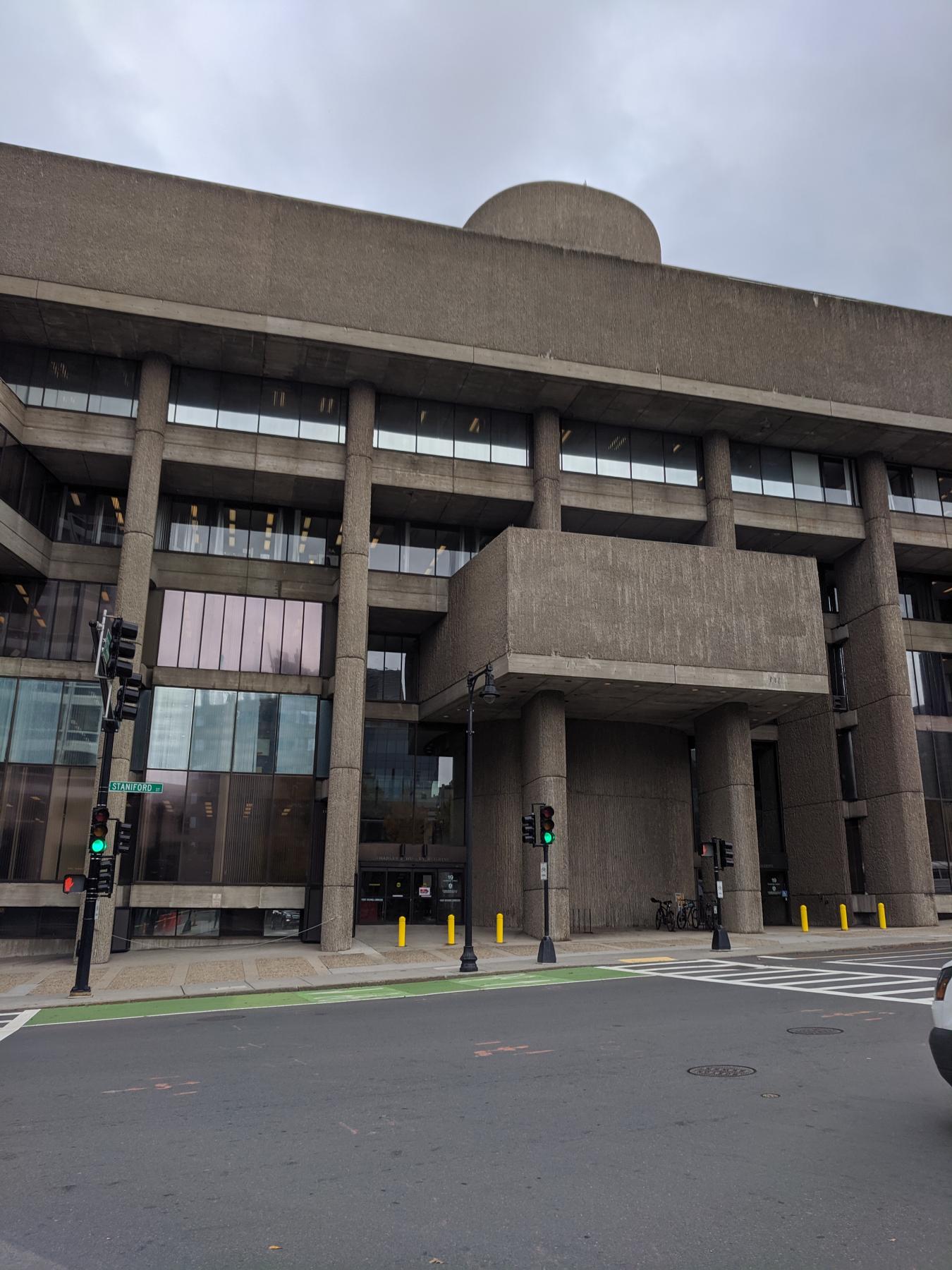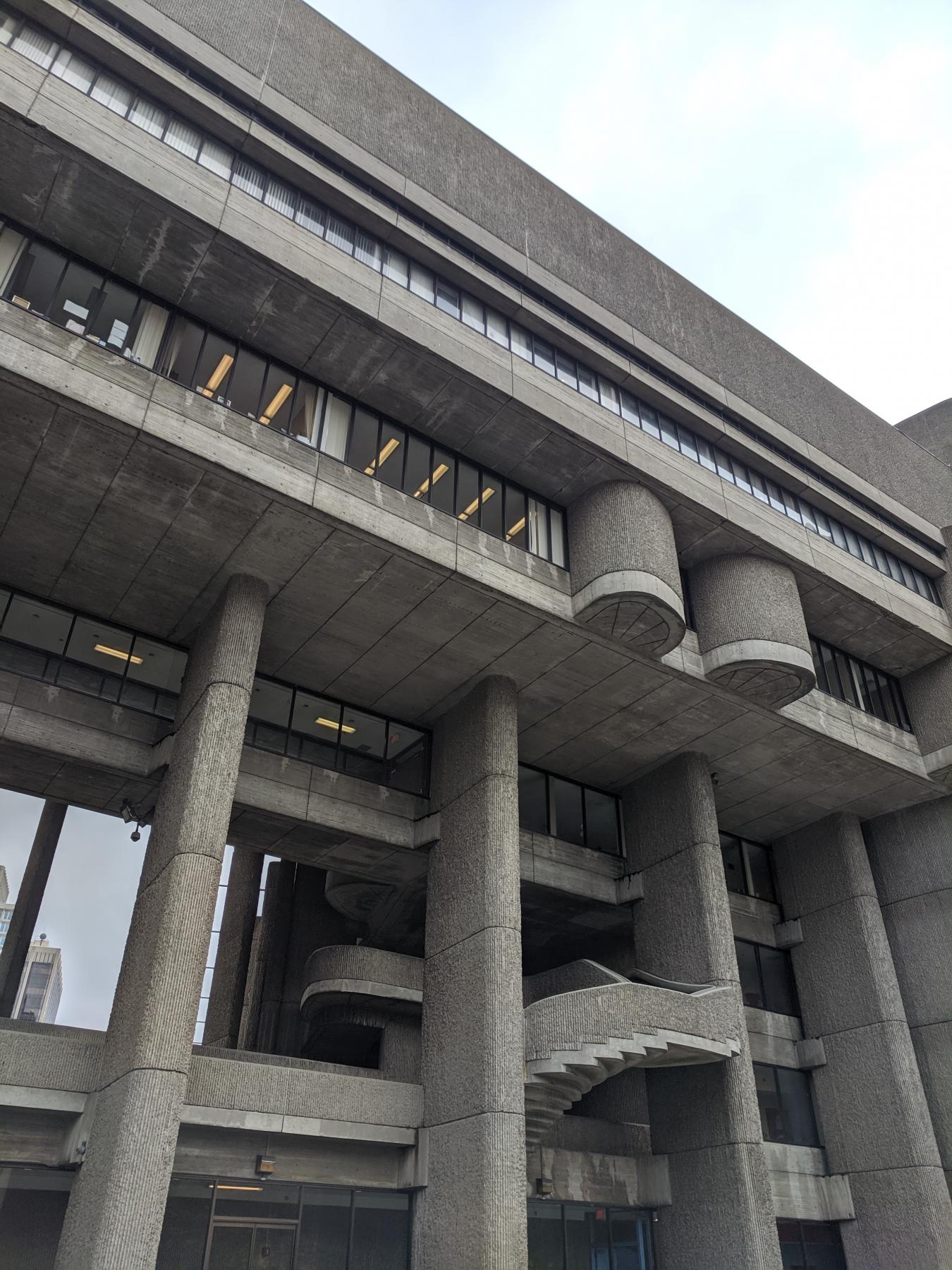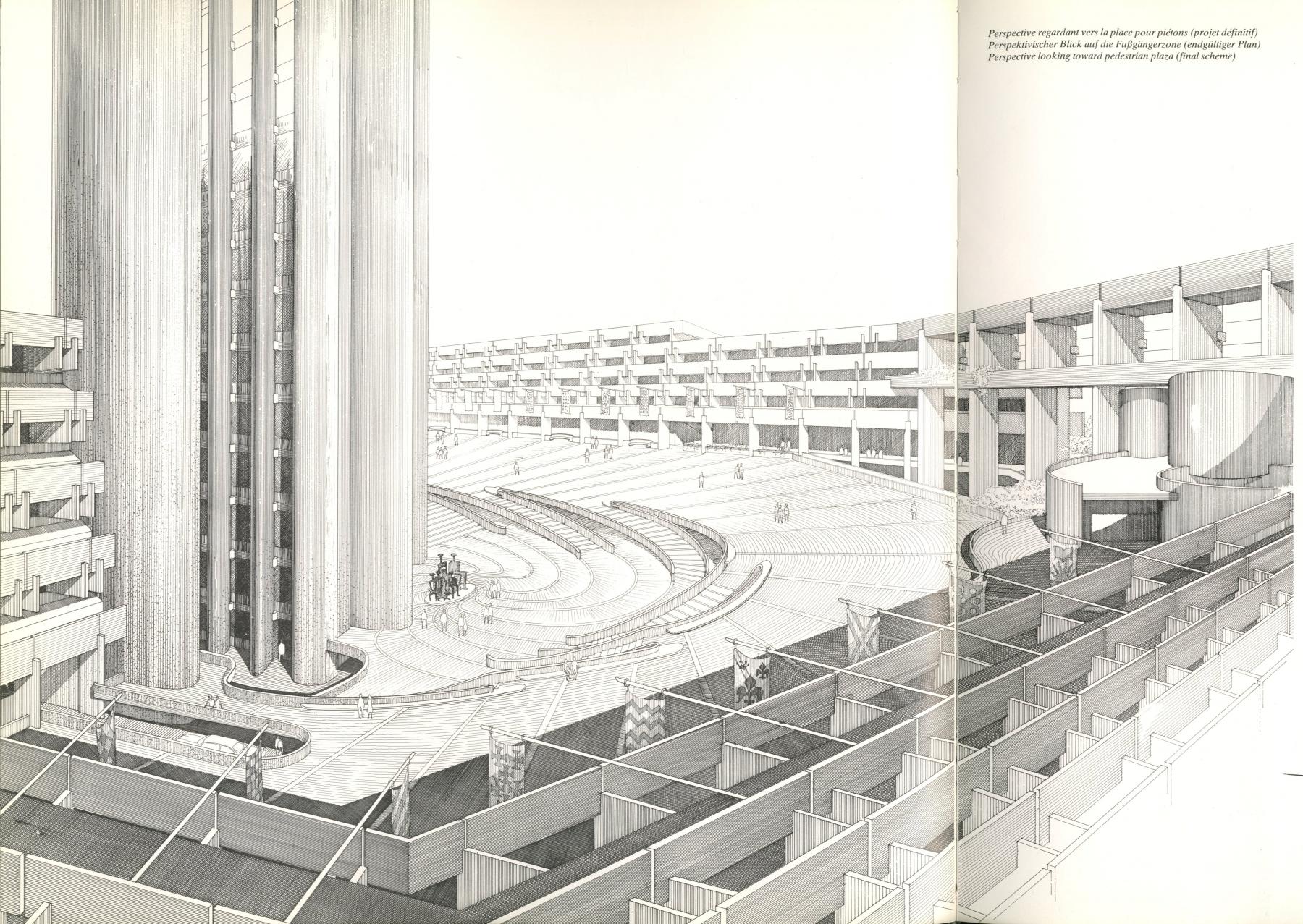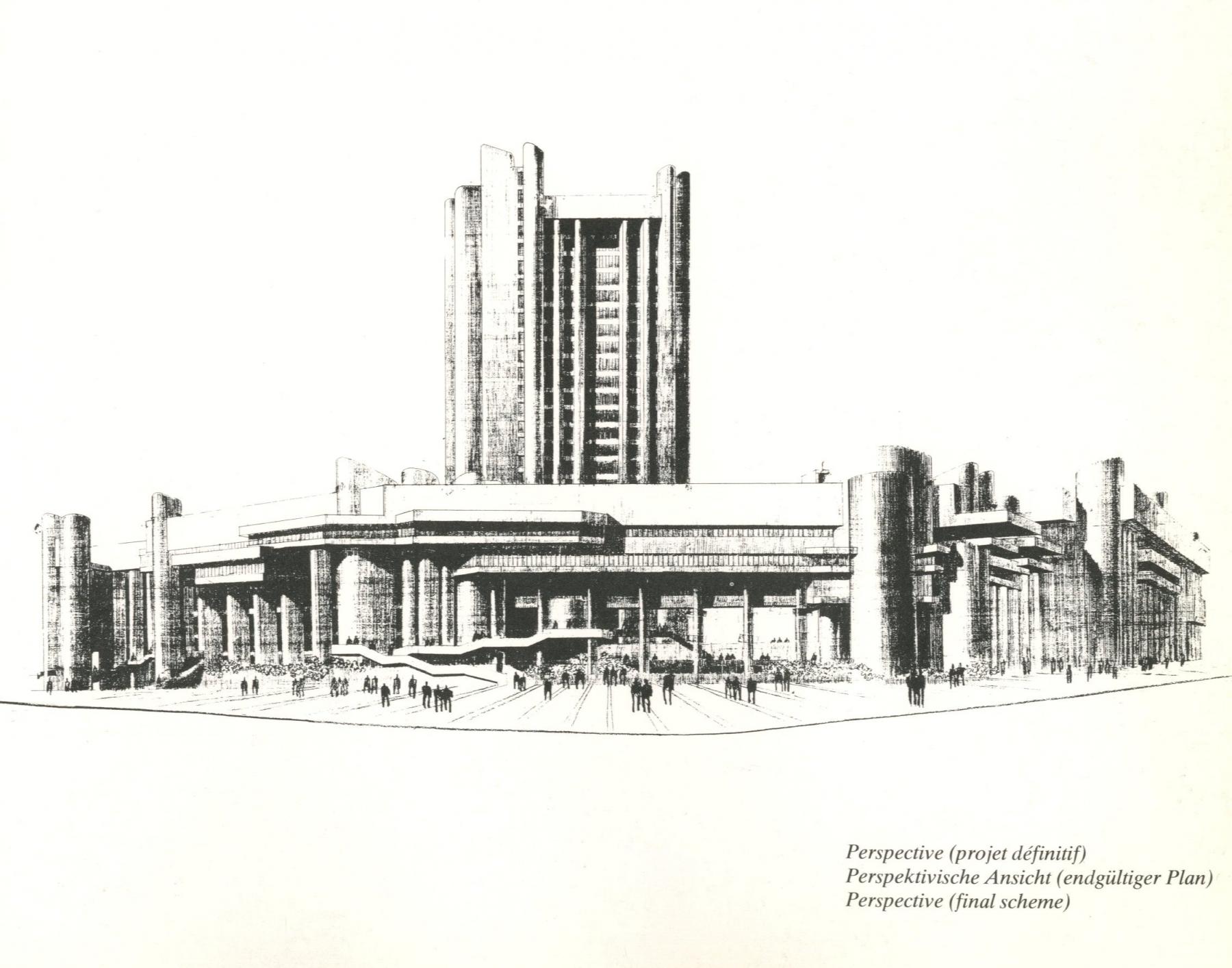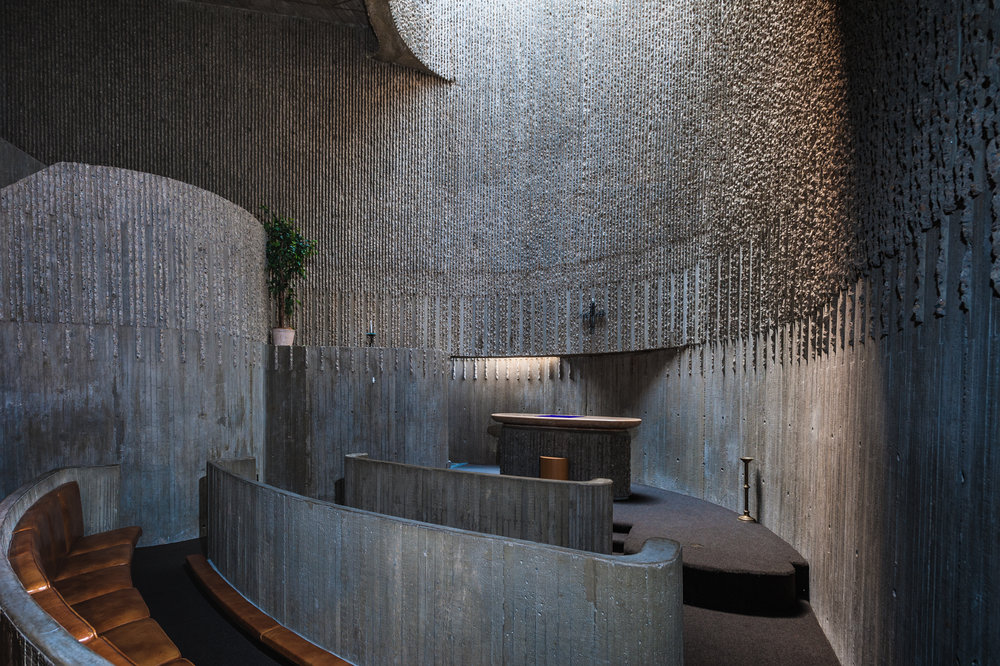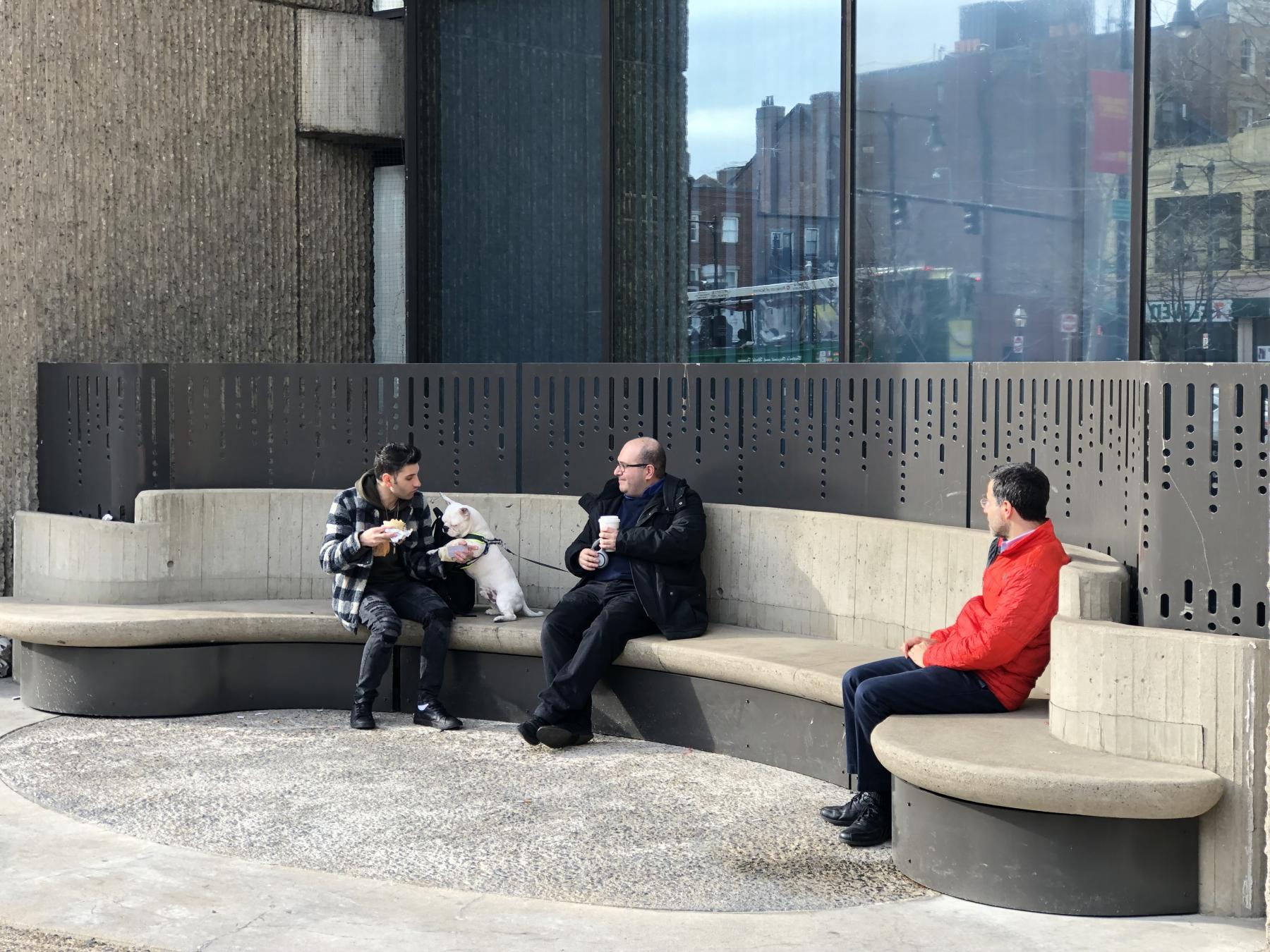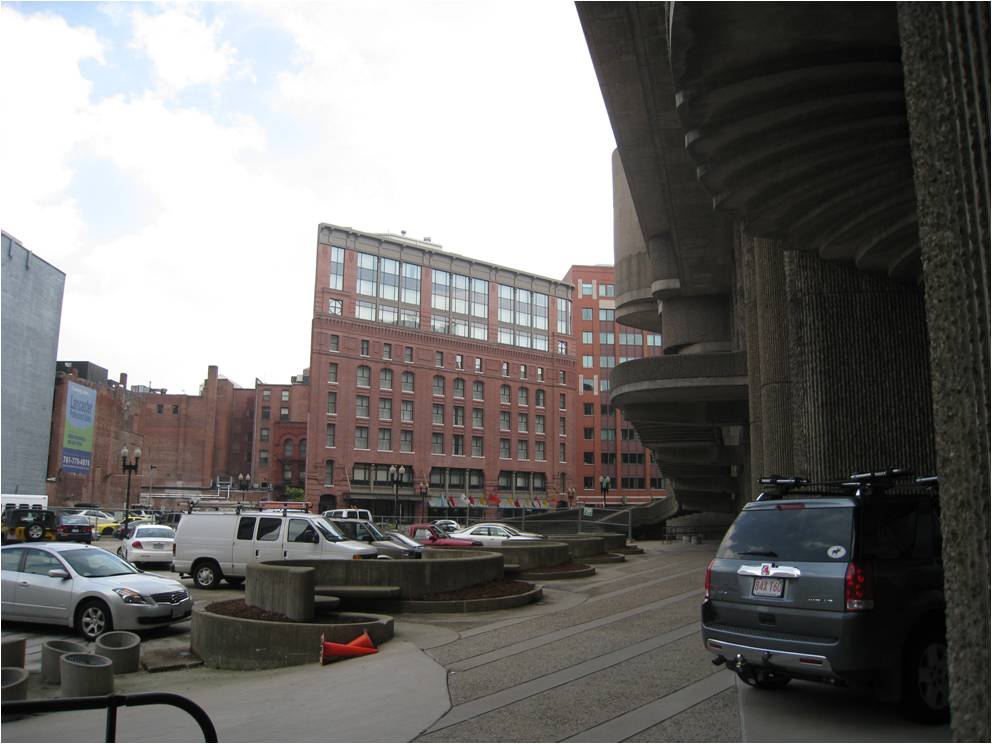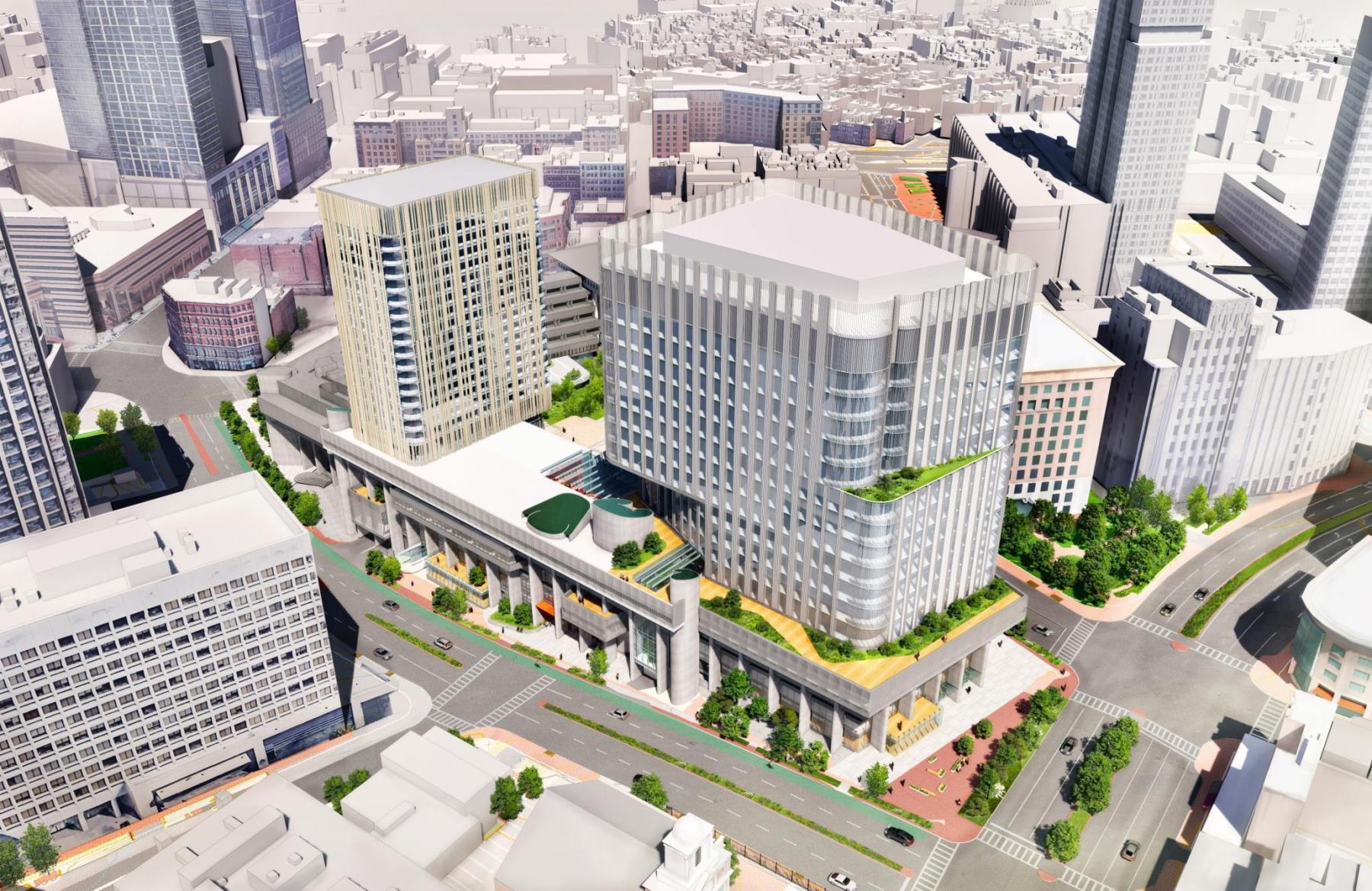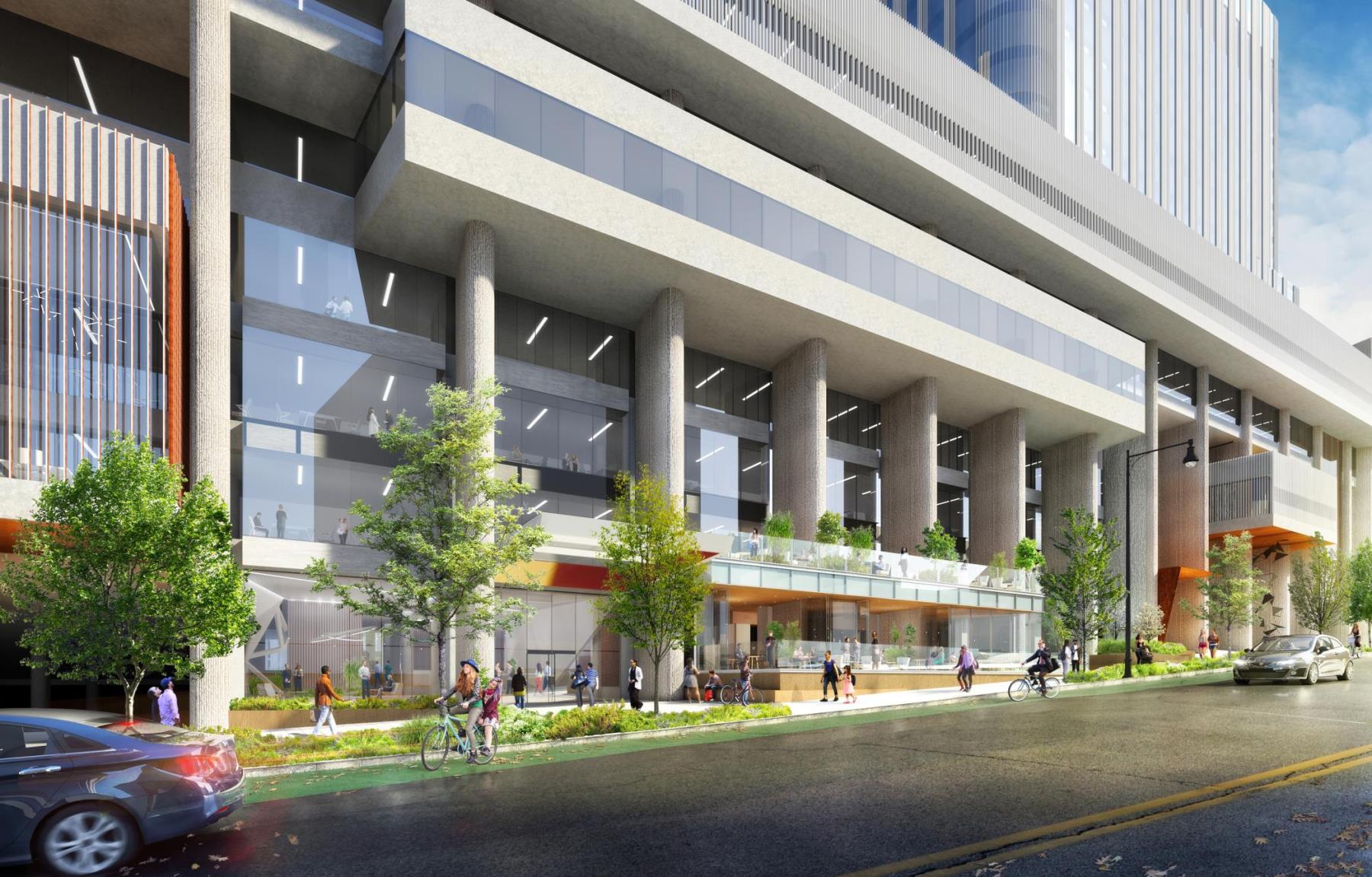42.362699, -71.0627
It is important to provide some context for this unique complex of buildings. Parts of downtown and the West End were razed in the late 1950s when Boston was in a deep economic slump with a rapidly decreasing population. The idea was to help rejuvenate the city through investment, starting with government facilities, and to create a new concept of centralized local government. What was designed, built, and ultimately not built on these sites knits together a narrative of social, political, and economical evolution in Boston. The Government Services Center makes a strong architectural statement about the mid-century mindset of local leadership attempting to reinvent a changing city and the important role that design played in this transformation.
Though the architectural term, Brutalism, is often misconstrued as meaning “brutal” in design or materiality, these concrete buildings were actually designed to be sculptural and an intentional contradiction to the glass and steel of the International Style popular in the postwar decades. According the the authors of Heroic: Concrete Architecture and the New Boston, these building were “Originally seen as reflecting the democratic attributes of a powerful civic expression- authenticity, honesty, directness, strength…” but eventually came to signify, “hostility, coldness, and inhumanity.” This perception has been perpetuated and exacerbated, unfortunately, by decades of deferred maintenance and poor stewardship that has failed to maintain the original design features, creative playfulness, and grandeur of these spaces. Thankfully there is a growing appreciation for these designs, particularly among younger generations who seem to be able to look past the abuse these buildings have taken and see instead the creativity of the designers and opportunities that rehabilitation could provide.
Of the three planned buildings for the Government Services Center, only two were built:
1. Hurley Employment Security Building, Cambridge Street between Staniford and New Chardon (Shepley, Bulfinch, Richardson & Abbott, architects)- completed
2. Lindemann Mental Health Building, corner of Staniford and Merrimac streets (Desmond & Lord, architects. Paul Rudolph, architectural design)- completed
3. Health, Welfare & Education Building, New Chardon Street, 28- story tower- never built
Paul Rudolph was appointed coordinating architect for the entire site and created a unified vision with elements such as massive columns, sun shades in the courtyard, similar fenestration throughout, and the consistent use of concrete, especially the iconic bush-hammered, corrugated (corduroy appearance) surfaces that were created by hand. Critic Ada Louise-Huxtable described the design as “the most advanced form of a progressive trend that will soon be punctuating the bland, glass-walled vistas of American cities with rugged, concrete buildings in eccentric, sculpted form.” Rudolph has been recognized as a leading architect of the Modernist era, serving as Chair of Yale University’s School of Architecture and famously designing the Yale Art and Architecture Buildings, among many others. Rudolph studied at Harvard under Bauhaus founder Walter Gropius and alongside other preeminent architects of the 20th century such as IM Pei and Philip Johnson.
In 1999, the Edward W. Brooke Courthouse was completed on this site, near where the original tower was designed to be built. This building is a distinct architectural expression, not a fulfillment of the original intent for the site.
DCAMM (Division of Capital Asset Management and Maintenance), the state division that owns and oversees this property.
BLC (Boston Landmarks Commission), the agency of local government that is active in ongoing conversations about this site.
DOCOMOMO (Documentation and Conservation of Buildings, Sites, and Neighborhoods of the Modern Movement), an international advocacy organization urging preservation of this site.
MHC (Massachusetts Historical Commission)
Our Position
The Government Services Center is historically significant for its team of architects, especially Paul Rudolph, its design, materiality, and architectural statement. Still today, the concrete complex stands in sharp contrast to common curtain-wall construction and the standard glass and metal we see throughout the city. The Alliance feels that the original buildings play a critical role in the landscape of Boston, telling an important story about the evolution of American design. The buildings could embrace a new life if properly upgraded. Through creative design approaches to managing fall hazards on the site, the long-standing fencing that surrounded the Hurley Building was removed in 2018 and we played a critical role in that effort. While recognizing the physical and programmatic challenges we appreciate the state’s clear position to rehabilitate the Lindemann Building and urge the redevelopment program for the Hurley Building to preserve as much of the building as possible. Creative, sensitive modifications to keep the site functional relevant to contemporary needs are attainable without wholesale demolition, and there is a great desire in the community to preserve the integrity of this complex.
The Alliance worked behind the scenes as part of DCAMM’s consultation process to advocate for a preservation solution for the site. A round of proposals were submitted, but ultimately a site use plan that focused more heavily on office space failed to move forward in a post-COVID world. The Alliance continues to work behind the scenes advocating for adaptive reuse of the site. In 2024, DCAMM reached out to the Alliance with a revised site plan that has a larger focus on housing and also includes the Lindemann building in the proposal. The Alliance continues to engage with the community, city and, state agencies to ensure that all stakeholders are heard and that the project evolves in a way that celebrates and enhances the original design and intentions of this historic site.
Highlights from our activity log:
- May 1, 2025
A draft proposal for the site including both the Lindemann Building and the Hurley Building was shared with the public. DCAMM’s proposal entails offering the 5.5-acre site of the Lindemann and Hurley Buildings located at 19 & 21 Staniford Street in Downtown Boston for redevelopment by a private developer for a mixed-use development, anchored by housing. The Department of Mental Health (DMH) intends to continue to operate its residential treatment programs onsite, and the selected developer will be required to build new space on or in very close proximity to the site to accommodate these programs as part of their development. DCAMM intends to offer a long-term ground lease (up to 99 years) to the selected development team.
Public comment is open until June 9 and is encouraged via email, Lindemann-Hurley.dcamm@mass.gov.
More information is available on the state’s website, linked here.
- November 2024
DCAMM connects with the Alliance about a change of scope for Government Services Center. The Alliance is supportive of the draft guidelines and future uses proposed for the site and continues to be actively involved.
- August 24, 2022
DCAMM announces its selection of the team that will be redeveloping the site: Leggat McCall Properties. The announcement is attached below and more information can be found at the project website. The Alliance issues the following statement:
The Boston Preservation Alliance has been engaged with the Hurley site for years, working closely with the state through DCAMM’s consultation process. We had the opportunity to provide recommendations for the preservation of the site’s significant historic and architectural features and to give feedback on proposals. After careful consideration, we communicated to DCAMM that our preferred proposal was the Leggat McCall Properties proposal and we are pleased that this partnership is moving forward.
The Alliance anticipates further dialogue with Boston residents and other advocates, the City, and the project team to ensure this project is meeting the needs of the neighborhood while preserving and celebrating this unique, historic site. We appreciate DCAMM’s inclusion of historic preservation advocates during the consultation process and while some interventions and compromises will be necessary in this redevelopment, we feel this is an opportunity to better utilize the Government Services Center complex, increase porosity through the site and improve the urban realm, and add new uses and programming to this area of downtown. We will continue to offer feedback and guidance as the project continues through its next phases.
- July 22, 2021
DCAMM makes public a Redevelopment Offering for the Charles F. Hurley Building. DCAMM expects to competitively procure a redevelopment partner over the coming months. DCAMM has spent the last year and a half engaging with neighbors, historic preservation advocates, elected officials, an informal advisory group (including Alliance ED Greg Galer), and other stakeholders to gather input to inform the offering materials and selection process. This comprehensive outreach and engagement process included the development of design guidelines that lay out development expectations including a preference that redevelopment proposals prioritize adaptive reuse or rehabilitation of the existing building. Alliance staff provided feedback to the draft Offering language before it was made public, suggesting stronger language to highlight the historic significance and value of the property and the desire for reuse instead of all new construction. To review the offering and register to submit a proposal, click here.
DCAMM has assured Alliance staff that we will continue to be a part of the process, and have expressed clearly and with appreciation that our efforts to date altered their perspective from an offering which directed interested parties to focus on complete demolition to one that acknowledges the historic and architectural significance and opportunities for a creative redevelopment and adaptation of the existing buildings. We have been told that proposals that propose full demolition will not be considered competitive or viable.
- February 19, 2021
DCAMM informs the advisory committee that the Commonwealth’s Asset Management Board approved DCAMM’s Final Project Proposal for the redevelopment of the Hurley Building. This was the final procedural step in DCAMM becoming authorized to move ahead with the disposition.
The next step will be to issue an RFP, which DCAMM projects to happen in a few months. MHC will be consulted for review and comments and the Alliance expects to be part of the process.
The Final Project Proposal is attached below.
- December 17, 2020
A public hearing is scheduled to focus on DCAMM’s Project Proposal to the Asset Management Board (the state board that can authorize DCAMM to pursue this project). As such, it will be more about how DCAMM is defining the business deal than about the expected design. Information about how to join the meeting and submit comments is below, and addition information is available at the project website.
|
|
- December 16, 2020
The Mass. Historical Commission sends letter to DCAMM, noting “The staff of the Massachusetts Historical Commission (MHC) have reviewed the draft design guidelines and find them responsive to MHC’s May 20, 2020 letter. MHC staff are encouraged that the design guidelines promote preservation and adaptive reuse/rehabilitation rather than outright demolition of the historic Hurley Building.” (Full letter below.)
- November 19, 2020
A community meeting is held. The recording can be viewed here. The presentation slides can be found here.
- November, 2020
After adopting many recommendations from an advisory committee to DCAMM (which included Alliance Executive Director Greg Galer), DCAMM submits to MHC draft design Guidelines for MHC comment. Note the language that encourages preservation and adaptation of the existing resources rather than outright demolition. These guidelines will be discussed at an upcoming public meeting with requests for public comment.
- May 19, 2020
Alliance staff are invited to a virtual meeting with Abigail Vladeck of DCAMM who is managing the Hurley Building project. Abi shares goals for the pending Request for Proposals (RFP) and staff give feedback about what kind of language would be appropriate to promote preservation-friendly responses. The Alliance will continue to be a leading voice in the process to craft an RFP that encourages creative approaches to adaptive reuse that embrace the historic fabric and character of the building and site. The Alliance offers to host a public meeting to discuss historic preservation.
- April 16, 2020
Alliance staff joins a virtual meeting hosted by the Beacon Hill Civic Association with a presentation from DCAMM about the project, timeline, and expectations. The timeline for the project remains largely unchanged, though meetings will be virtual for the foreseeable future. Many community members on the call express support for preservation of the building, and there is a call for including a public school and/or a senior services center on the site as part of the redevelopment.
- April 15, 2020
The Alliance is copied on a letter from DCAMM to MHC in response to MHC’s February 25, 2020 letter about the project. The response, attached below, clarifies the state’s position on certain elements of the project noting: “It is not our intent to prescribe any particular approaches to demolition or retention to RFP respondents. Rather, we intend to invite proposals that strive to preserve all or key portions of the Hurley Building (identified in the Preservation Report) through creative, adaptive reuse while also introducing new development to the site in a way that is sensitive to historic context and to the surrounding built environment … In addition to evaluating proposals on the quality, quantity, and price of space for Commonwealth occupancy, we will also evaluate them for design excellence, responsiveness to our guidance in the RFP regarding preservation and adaptive reuse, and other qualitative criteria.” The Alliance will continue to engage with the consultation process.
- February 25, 2020
MHC sends their response to the PNF. MHC has determined that the proposed project will have an “adverse effect” and “looks forward to consulting with consulting with DCAMM to seek ways to avoid, minimize, or mitigate the adverse effects of the proposed demolition.” See details in the full document linked below.
- February 21, 2020
The Alliance submits comments to MHC in response to the PNF submitted by DCAMM. The letter supports a degree of change at this site, but cautions against dramatic alterations that do not embrace the significant features of the historic Hurley building. It also calls for a commitment to repair and restore the Lindemann Mental Health Center building. The letter is attached below, with a 2.26.20 edit.
- January 24, 2020
DCAMM submitted a Project Notification Form to MHC for the proposed long-term lease of the Hurley Building. See the attached PNF below. The Alliance will submit a comment letter in response.
- November 15, 2019
A newly-formed group called Save the Boston Government Services Center Coalition launches an online petition with the mission to “protect this important piece of late modern urban design.”
- November 8, 2019
The Alliance joins DCAMM for a meeting with their consultant team and other members of the preservation community to discuss next steps for the project and tour the site. DCAMM emphasizes that they are early in the process and plan to be collaborative with the Alliance and other partners as this proposal moves forward. They will soon be filing a Project Notification Form with the MA Historical Commission. Anticipating a ruling of “adverse effect” to the historic resource from MHC, the team plans to create a Memorandum of Agreement working towards a Request for Proposals, which the Alliance will assist in drafting. Though DCAMM can not guarantee what the end result will be, it was clear that the team understood the significance of the site, desired to work collaboratively, and would seek proposals that are respectful to Paul Rudolph’s architectural vision. The team would prefer proposals that accomplish state goals while creatively enhancing the Hurley Building and the complex and address a variety of current deficiencies. The Alliance will remain engaged with this process as it moves forward to advocate for thoughtful preservation and redevelopment. The Alliance also emphasized the importance of investing in the Lindemann Building as part of this project to assure its continued success in this historic complex.
- October 30, 2019
DCAMM representatives reach out to the Alliance to inform us of a new plan for the site that will soon be released to the media. The Alliance is told that this relates only to the Hurley Building and that the state is committed to investing in and preserving the Lindemann Building. We are also given assurances that DCAMM’s goal is for this to be a collaborative process, that they are very early and just developing an RFP, and that they want the Alliance to be involved in its development. The goal is to receive creative proposals in which preservation and modification of the Hurley Building are emphasized in whatever redevelopment occurs. Media reports follow in subsequent days and suggest that the Baker administration plans to redevelop the Hurley Building and issue a ground lease to a developer who would design, plan, and construct a new office complex. The Alliance engages in multiple conversations with members of the preservation community.
- March, 2018
The fencing project is complete and the temporary chain-link fence is removed. The Alliance immediately observes public engagement with the building, using the benches that are now accessible.
- May 8, 2017
The Alliance attends a meeting to review the new fencing proposal- water-jet cut sheets of metal with patterns inspired by the chapel inside the building. Lighting work that was previously approved will be included with this project.
- February 21, 2017
The Alliance attends a meeting with DCAMM, other members of the preservation community, and a new design team for the project. The new safety fencing above open light wells is now proposed as perforated metal panels with custom patterns. The scheme previously agreed upon was too expensive and this new proposal appears to be effective, appropriate in design, and more financially viable.
- August 22, 2016
The Alliance attends a meeting with DCAMM and the design team who ask for guidance about priorities for the scope of work on the site, including changes to the new fencing or fewer repairs to the concrete.
- November 16, 2015
The Alliance meets with DCAMM to review the proposal for new fencing, required for life safety upgrades at the site. Assurances are made that this project will be moving forward despite ongoing conversations about the use of the building. The Alliance is given the opportunity to review and comment on the design of the fencing as it progresses and is supportive of the direction.
- October 2015
The Alliance submits a comment letter (below) to DCAMM noting the division’s commitment to rehabilitating the site rather than compromising it through partial or complete demolition. The letter makes several suggested edits to the language of the draft report, including more emphasis on the architect, Paul Rudolph, and the site’s historic significance.
- January-February 2015
Alliance Executive Director Greg Galer attends a series of meetings with DCAMM, BLC, and others to develop a scheme for designing a railing behind benches and low walls, which are in front of deep light wells, to improve safety throughout the site so that temporary chain-link fencing can be removed. The Alliance emphasizes how much the fencing detracts from the building and reinforces negative perceptions of the design.
- November 2013
The Alliance participates in a meeting to discuss proposed changes to the Lindemann Building site and raises concerns about removing historic fabric to allow for more parking. The Alliance joined a Memorandum of Agreement to review future proposals along with the Massachusetts Historical Commission and the Boston Landmarks Commission. DCAMM (the Division of Capital Asset Management and Maintenance) is responsive and seems to appreciate the historic significance of the site, agreeing to reduce the scope of this project to protect historic features. This opens up a positive avenue of communication between DCAMM and the Alliance regarding the entire complex.

